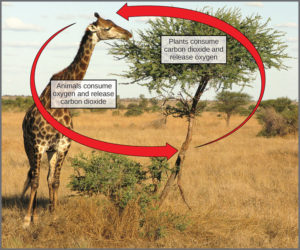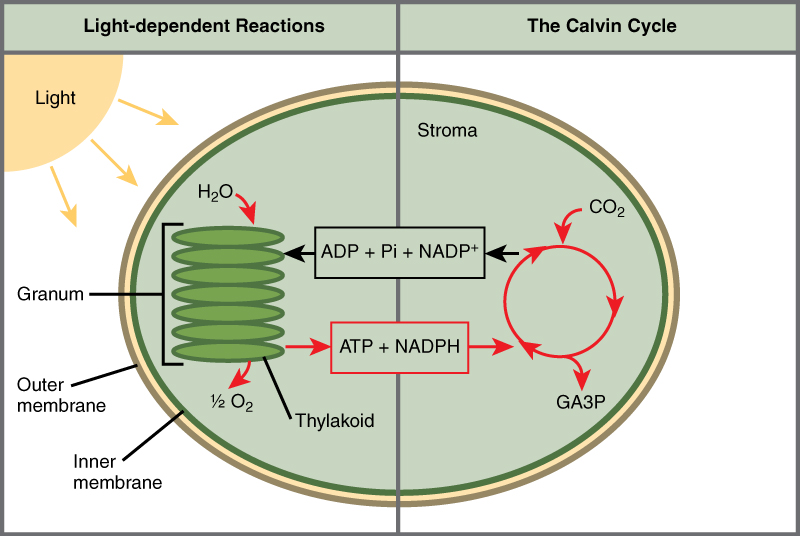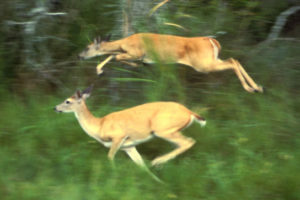51 Putting Photosynthesis into Context
All living things require energy. Carbohydrates are storage molecules for energy. Living things access energy by breaking down carbohydrate molecules during the process of cellular respiration. Plants produce carbohydrates during photosynthesis. So if plants make carbohydrate molecules during photosynthesis, do they also perform cellular respiration? The answer is yes, they do. Although energy can be stored in molecules like ATP, carbohydrates (and lipids, which can also enter cellular respiration as a source of energy) are much more stable and efficient reservoirs for chemical energy. Photosynthetic organisms also carry out the reactions of respiration to harvest the energy that they have stored in carbohydrates during photosynthesis. Plants have mitochondria in addition to chloroplasts.
The energy that is harnessed from photosynthesis enters the ecosystems of our planet continuously and is transferred from one organism to another. Therefore, directly or indirectly, the process of photosynthesis provides most of the energy required by living things on earth.
Photosynthesis also results in the release of oxygen into the atmosphere. In short, to eat and breathe, humans depend almost entirely on the organisms that carry out photosynthesis.
The overall reaction for photosynthesis:
6CO2 + 6H2O + sunlight → C6H12O6 + 6O2
is the reverse of the overall reaction for cellular respiration:
Photosynthesis produces oxygen as a byproduct, and respiration produces carbon dioxide as a byproduct. In nature, there is no such thing as waste. Every single atom of matter is conserved, recycling indefinitely. Substances change form or move from one type of molecule to another, but never disappear (Figure 1).
CO2 is no more a form of waste produced by respiration than oxygen is a waste product of photosynthesis. Both are byproducts of reactions that move on to other reactions. Photosynthesis absorbs energy from sunlight to build carbohydrates in the chloroplasts, and aerobic cellular respiration releases that stored energy by using oxygen to break down carbohydrates. Both organelles use electron transport chains to generate the energy necessary to drive other reactions. Photosynthesis and cellular respiration function in a biological cycle, allowing organisms to access life-sustaining energy that originates millions of miles away in a star.

There are two basic parts of photosynthesis: the light dependent reactions and the light independent reactions (also known as the Calvin cycle). During the light reactions, the energy from sunlight is stored in energy carrier molecules. These energy carrier molecules are then used to power the reactions of the Calvin cycle, where CO2 molecules are joined together to produce carbohydrates such as glucose.

Solar Dependence and Food Production
Some organisms can carry out photosynthesis, whereas others cannot. An autotroph is an organism that can produce its own food. The Greek roots of the word autotroph mean “self” (auto) “feeder” (troph). Plants are the best-known autotrophs, but others exist, including certain types of bacteria and algae (Figure 1). Oceanic algae contribute enormous quantities of food and oxygen to global food chains. Plants are also photoautotrophs, a type of autotroph that uses sunlight and carbon from carbon dioxide to synthesize chemical energy in the form of carbohydrates. All organisms carrying out photosynthesis require sunlight.

Heterotrophs are organisms incapable of photosynthesis that must therefore obtain energy and carbon from food by consuming other organisms. The Greek roots of the word heterotroph mean “other” (hetero) “feeder” (troph), meaning that their food comes from other organisms. Even if the food organism is another animal, this food traces its origins back to autotrophs and the process of photosynthesis. Humans are heterotrophs, as are all animals. Heterotrophs depend on autotrophs, either directly or indirectly. Deer and wolves are heterotrophs. A deer obtains energy by eating plants. A wolf eating a deer obtains energy that originally came from the plants eaten by that deer. The energy in the plant came from photosynthesis, and therefore it is the only autotroph in this example (Figure 2). Using this reasoning, all food eaten by humans also links back to autotrophs that carry out photosynthesis.

References
Unless otherwise noted, images on this page are licensed under CC-BY 4.0 by OpenStax.
Text adapted from: OpenStax, Biology. OpenStax CNX. November 11, 2017. https://cnx.org/contents/GFy_h8cu@10.118:W7ctJeSI@8/Overview-of-Photosynthesis

